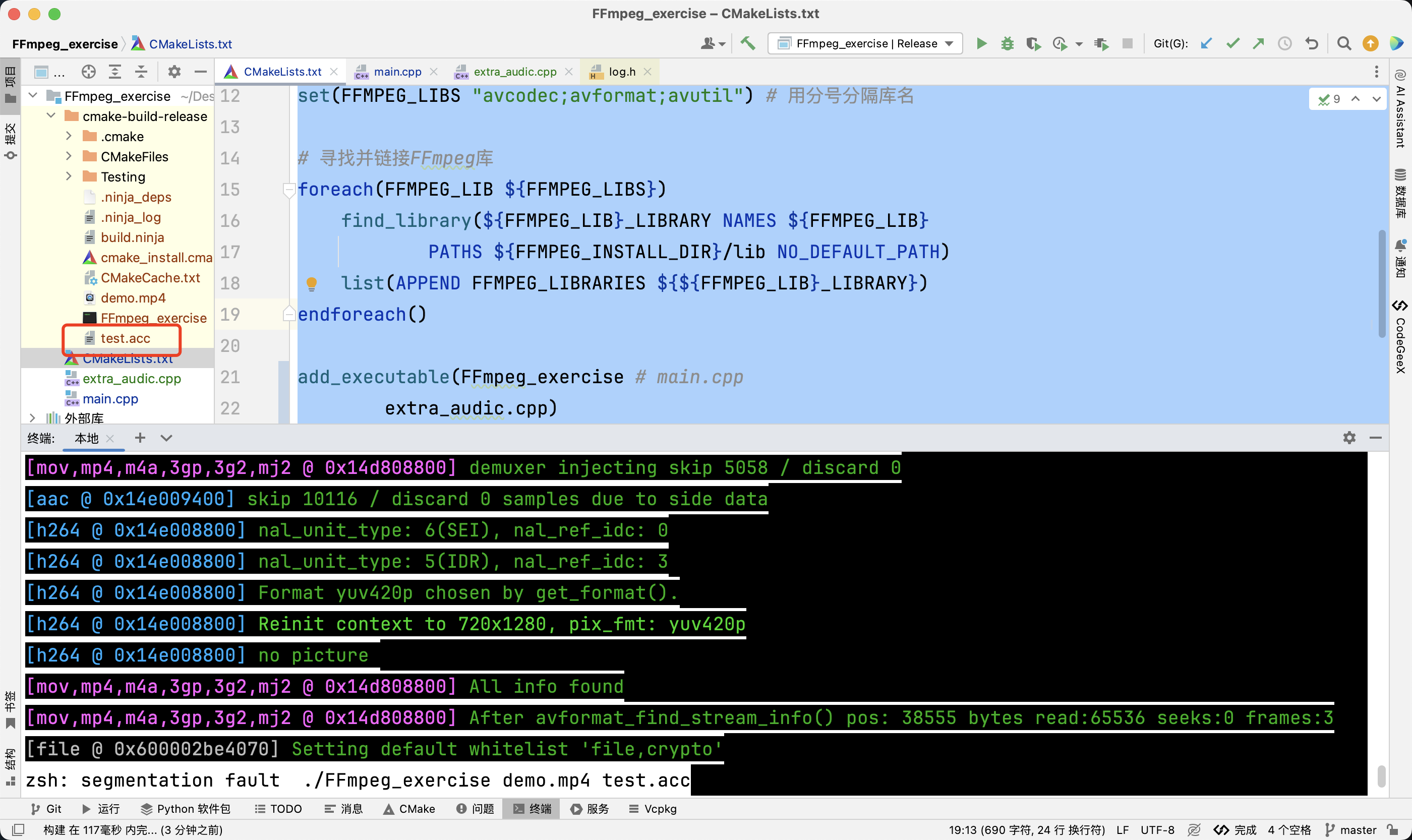ffmpeg音视频开发从入门到精通——ffmpeg实现音频抽取
文章目录
- FFmpeg 实现音频流抽取
- 1. 包含FFmpeg头文件与命名空间声明
- 2. 主函数与参数处理
- 3. 打开输入文件
- 4. 获取文件信息
- 5. 查找音频流
- 6. 分配输出文件上下文
- 7. 猜测输出文件格式
- 8. 创建新的音频流
- 9. 打开输出文件
- 10. 写入文件头信息
- 11. 读取并写入音频数据
- 12. 写入文件尾部信息并释放资源
- 运行程序
- 注意事项
- 抽取音频完整代码
FFmpeg 实现音频流抽取
1. 包含FFmpeg头文件与命名空间声明
使用FFmpeg库前需要包含相应的头文件,并在C++中声明外部C函数的命名空间。
#ifdef __cplusplus
extern "C" {
#endif
#include <libavformat/avformat.h>
#include <libavutil/avutil.h>
#include <libavutil/log.h>
#ifdef __cplusplus
}
#endif
2. 主函数与参数处理
程序入口点,处理命令行参数。
int main(int argc, char *argv[]) {
// 参数检查
if (argc < 3) {
av_log(nullptr, AV_LOG_INFO, "参数必须多于3个\n");
exit(-1);
}
// 输入输出文件路径
char *src = argv[1];
char *dst = argv[2];
// ...
}
3. 打开输入文件
使用avformat_open_input打开输入文件。
avformat_open_input 是 FFmpeg 库中的一个函数,用于打开输入媒体文件并读取其格式信息。这个函数是 FFmpeg 中处理多媒体文件的基础之一,通常准备解码和处理音视频流。
- 函数原型
int avformat_open_input(AVFormatContext **ps, const char *url, AVInputFormat *fmt, AVDictionary **options);
-
输入参数
-
AVFormatContext **ps:
- 这是一个指向
AVFormatContext指针的指针。AVFormatContext是一个结构体,包含了关于输入媒体文件的所有信息,包括流的信息、格式、时长等。 - 在调用
avformat_open_input之前,通常需要先分配一个AVFormatContext结构体的内存(可以使用avformat_alloc_context()函数),然后将其地址传递给该参数。 - 如果函数成功,
*ps将指向一个已填充的AVFormatContext结构体。
- 这是一个指向
-
const char *url:
- 这是一个指向字符串的指针,表示要打开的媒体文件的路径或 URL。可以是本地文件路径,也可以是网络流的 URL(如 HTTP、RTSP 等)。
-
AVInputFormat *fmt:
- 这是一个指向
AVInputFormat结构体的指针,表示希望使用的输入格式。如果为NULL,FFmpeg 将自动检测输入文件的格式。 - 你可以通过
av_find_input_format函数来查找特定的输入格式。
- 这是一个指向
-
AVDictionary *options:
- 这是一个指向字典的指针,用于传递额外的选项给输入格式。字典中的每个键值对都可以用来设置特定的解码选项,例如缓冲区大小、超时设置等。
- 如果没有额外的选项,可以将此参数设置为
NULL。
-
-
返回值
- 函数返回一个整数值:
- 如果成功,返回
0。 - 如果失败,返回一个负数,表示错误代码。可以使用
av_strerror函数将错误代码转换为可读的错误信息。
- 如果成功,返回
- 示例代码
以下是一个简单的示例,展示如何使用 avformat_open_input 打开一个媒体文件:
#include <libavformat/avformat.h>
int main() {
AVFormatContext *formatContext = NULL;
const char *filename = "input.mp4"; // 输入文件名
int ret;
// 注册所有的文件格式和编解码器
av_register_all();
// 打开输入文件
ret = avformat_open_input(&formatContext, filename, NULL, NULL);
if (ret < 0) {
char errbuf[128];
av_strerror(ret, errbuf, sizeof(errbuf));
fprintf(stderr, "Could not open source file %s: %s\n", filename, errbuf);
return ret;
}
// 打印文件信息
av_dump_format(formatContext, 0, filename, 0);
// 关闭输入文件
avformat_close_input(&formatContext);
return 0;
}
avformat_open_input 是 FFmpeg 中用于打开和读取媒体的关键函数。通过正确设置输入参数,可以方便地打开各种格式的音视频文件,并获取其相关信息。
ret = avformat_open_input(&pFmtCtx, src, nullptr, nullptr);
if (ret < 0) {
av_log(nullptr, AV_LOG_ERROR, "打开输入文件失败\n");
exit(-1);
}
4. 获取文件信息
调用avformat_find_stream_info获取多媒体文件的流信息。
avformat_find_stream_info 是 FFmpeg 库中的一个函数,用于读取媒体文件的流信息(如音频流、视频流、字幕流等)。这个函数通常在成功打开输入文件后调用,以获取有关各个流的详细信息。
- 函数原型
int avformat_find_stream_info(AVFormatContext *ic, AVDictionary **options);
-
输入参数
-
AVFormatContext *ic:
- 这是一个指向
AVFormatContext结构体的指针,该结构体在调用avformat_open_input时被填充。它包含了关于打开的媒体文件的所有信息,包括流的数量、每个流的类型、编解码器信息等。 - 在调用
avformat_find_stream_info之前,必须确保已经成功打开了媒体文件并且AVFormatContext已经被正确初始化。
- 这是一个指向
-
AVDictionary **options:
- 这是一个指向字典的指针,用于传递额外的选项给流信息查找过程。字典中的每个键值对可以用来设置特定的选项,例如解码器的参数、缓冲区大小等。
- 如果没有额外的选项,可以将此参数设置为
NULL。
-
-
返回值
- 函数返回一个整数值:
- 如果成功,返回
0。 - 如果失败,返回一个负数,表示错误代码。可以使用
av_strerror函数将错误代码转换为可读的错误信息。
- 如果成功,返回
avformat_find_stream_info 函数的主要作用是填充 AVFormatContext 中的流信息,以便后续处理和解码。通过正确设置输入参数,可以有效地获取媒体文件中各个流的详细信息。
if ((ret = avformat_find_stream_info(pFmtCtx, nullptr)) < 0) {
av_log(nullptr, AV_LOG_INFO, "获取文件信息失败\n");
exit(-1);
}
5. 查找音频流
遍历所有流,找到音频流的索引。
for (int i = 0; i < pFmtCtx->nb_streams; ++i) {
if (pFmtCtx->streams[i]->codecpar->codec_type == AVMEDIA_TYPE_AUDIO) {
idx = i;
break;
}
}
6. 分配输出文件上下文
使用avformat_alloc_context分配输出文件的格式上下文。
- 输入参数
- 无输入参数:
- 该函数不需要任何输入参数。
- 返回值
- **返回值:
- 返回一个指向
AVFormatContext结构体的指针。 - 如果内存分配失败,返回
NULL。
- 返回一个指向
- 总结
- 功能:分配并初始化一个新的
AVFormatContext结构体,用于存储媒体文件的格式信息。 - 用途:在打开媒体文件之前,通常需要调用此函数以准备好格式上下文。
oFmtCtx = avformat_alloc_context();
if (!oFmtCtx) {
av_log(nullptr, AV_LOG_ERROR, "分配输出文件上下文失败\n");
goto _ERROR;
}
7. 猜测输出文件格式
使用av_guess_format猜测输出文件的格式。
av_guess_format 是 FFmpeg 库中的一个函数,用于根据给定的文件扩展名或 MIME 类型来猜测媒体文件的格式。这个函数在处理多媒体文件时非常有用,尤其是在需要确定输入或输出格式时。
AVInputFormat *av_guess_format(const char *short_name, const char *filename, const char *mime_type);
- 功能
- 根据文件扩展名:通过提供的文件名的扩展名来猜测媒体格式。
- 根据 MIME 类型:如果提供了 MIME 类型,可以根据 MIME 类型来猜测格式。
- 返回相应的格式:返回一个指向
AVInputFormat结构体的指针,表示猜测的输入格式。如果无法猜测,则返回NULL。
- 参数
- *const char short_name:短名称(如 “mp4”、“avi” 等),用于直接匹配格式。
- *const char filename:文件名,通常包含扩展名,用于推断格式。
- *const char mime_type:MIME 类型字符串(如 “video/mp4”),用于进一步确认格式。
- 用途
- 在打开媒体文件之前,使用
av_guess_format可以帮助确定合适的输入格式,从而为后续的解码和处理做好准备。
outFmt = av_guess_format(nullptr, dst, nullptr);
oFmtCtx->oformat = outFmt;
8. 创建新的音频流
为输出文件创建一个新的音频流,并复制输入音频流的参数。
avformat_new_stream 函数:
-
输入参数
-
*AVFormatContext s:
- 指向
AVFormatContext结构体的指针,表示要在其中添加新流的格式上下文。
- 指向
-
*AVCodec c:
- 指向
AVCodec结构体的指针,表示新流所使用的编解码器。如果为NULL,则会使用默认编解码器。
- 指向
-
返回值:
- 返回一个指向新创建的
AVStream结构体的指针。如果创建失败,则返回NULL。
- 返回一个指向新创建的
-
-
总结
avformat_new_stream用于在给定的格式上下文中创建一个新的流,并可以指定其使用的编解码器。
outStream = avformat_new_stream(oFmtCtx, nullptr);
avcodec_parameters_copy(outStream->codecpar, inStream->codecpar);
outStream->codecpar->codec_tag = 0;
9. 打开输出文件
使用avio_open2打开输出文件准备写入。
avio_open2 是 FFmpeg 库中的一个函数,用于打开一个 I/O 设备(如文件、网络流等)以进行读写操作。这个函数提供了更灵活的选项来配置打开的方式和行为。
int avio_open2(AVIOContext **s, const char *url, int flags, AVDictionary **options);
- 功能
- 打开 I/O 设备:根据提供的 URL(可以是文件路径或网络地址)打开一个 I/O 设备。
- 配置选项:允许通过字典传递额外的选项,以定制打开设备的行为。
-
输入参数
-
**AVIOContext s:
- 指向
AVIOContext指针的指针,用于返回打开的 I/O 上下文。如果成功,*s将指向一个已初始化的AVIOContext结构体。
- 指向
-
*const char url:
- 指向字符串的指针,表示要打开的设备的 URL(例如文件路径或网络地址)。
-
int flags:
- 整数标志,用于指定打开设备的模式。常见的标志包括:
AVIO_FLAG_READ:以只读模式打开。AVIO_FLAG_WRITE:以写入模式打开。AVIO_FLAG_READ_WRITE:以读写模式打开。
- 整数标志,用于指定打开设备的模式。常见的标志包括:
-
**AVDictionary options:
- 指向字典的指针,用于传递额外的选项给打开过程。可以用来设置特定的参数,如超时、缓冲区大小等。如果没有额外的选项,可以将此参数设置为
NULL。
- 指向字典的指针,用于传递额外的选项给打开过程。可以用来设置特定的参数,如超时、缓冲区大小等。如果没有额外的选项,可以将此参数设置为
-
-
返回值
- 函数返回一个整数值:
- 如果成功,返回
0。 - 如果失败,返回一个负数,表示错误代码。
- 如果成功,返回
- 总结
avio_open2是用于打开 I/O 设备的关键函数,支持多种打开模式和配置选项,适用于文件和网络流的读写操作。
ret = avio_open2(&oFmtCtx->pb, dst, AVIO_FLAG_WRITE, nullptr, nullptr);
if (ret < 0) {
av_log(nullptr, AV_LOG_ERROR, "打开输出文件失败\n");
goto _ERROR;
}
10. 写入文件头信息
调用avformat_write_header写入文件头信息。
写入文件头:在输出文件中写入必要的头部信息,以便后续的数据流可以正确地被解析和播放。
初始化输出格式:根据 AVFormatContext 中的信息,设置输出格式并准备写入数据。
输入参数
*AVFormatContext s:
指向 AVFormatContext 结构体的指针,表示要写入的输出格式上下文。该结构体应在调用此函数之前被正确初始化,并且流信息应已设置。
**AVDictionary options:
指向字典的指针,用于传递额外的选项给写入头部的过程。可以用来设置特定的参数,如编码器选项、元数据等。如果没有额外的选项,可以将此参数设置为 NULL。
ret = avformat_write_header(oFmtCtx, nullptr);
if (ret < 0) {
av_log(nullptr, AV_LOG_ERROR, "写入文件头失败\n");
goto _ERROR;
}
11. 读取并写入音频数据
读取输入文件的音频数据,转换时间戳,并写入输出文件。
while (av_read_frame(pFmtCtx, &pkt) >= 0) {
if (pkt.stream_index == idx) {
// 转换时间戳等
pkt.pts = av_rescale_q_rnd(pkt.pts, inStream->time_base, outStream->time_base, AV_ROUND_NEAR_INF);
pkt.dts = pkt.pts;
// 写入输出文件
av_interleaved_write_frame(oFmtCtx, &pkt);
}
av_packet_unref(&pkt);
}
12. 写入文件尾部信息并释放资源
写入文件尾部信息,关闭文件,并释放所有分配的资源。
av_write_trailer(oFmtCtx);
avio_close(oFmtCtx->pb);
avformat_free_context(oFmtCtx);
_ERROR:
// 清理资源
if (pFmtCtx) {
avformat_free_context(pFmtCtx);
# avformat_close_input(&pFmtCtx);
}
if (oFmtCtx) {
avformat_free_context(oFmtCtx);
# avformat_close_input(&oFmtCtx); // 注意:应使用 avformat_free_context 代替
}
}
请注意,错误处理部分应使用avformat_free_context代替avformat_close_input来正确释放oFmtCtx资源。另外,程序中存在一些潜在的内存泄漏和错误处理问题,应进一步优化。
运行程序
程序需要传入至少两个参数:输入文件路径和输出文件路径。例如:
./my_ffmpeg_tool input.mp3 output.aac
注意事项
- 确保FFmpeg开发库已正确安装且可链接。
- 检查程序输出的错误信息以进行调试。
- 程序可能需要适当的读取和写入权限。
抽取音频完整代码
cmake_minimum_required(VERSION 3.27)
project(FFmpeg_exercise)
set(CMAKE_CXX_STANDARD 14)
# 定义FFmpeg的安装路径变量
set(FFMPEG_INSTALL_DIR "/usr/local/ffmpeg")
# 将FFmpeg的头文件目录添加到包含路径
include_directories(${FFMPEG_INSTALL_DIR}/include)
# 定义FFmpeg库的基础名称(根据你的需要调整)
set(FFMPEG_LIBS "avcodec;avformat;avutil") # 用分号分隔库名
# 寻找并链接FFmpeg库
foreach(FFMPEG_LIB ${FFMPEG_LIBS})
find_library(${FFMPEG_LIB}_LIBRARY NAMES ${FFMPEG_LIB}
PATHS ${FFMPEG_INSTALL_DIR}/lib NO_DEFAULT_PATH)
list(APPEND FFMPEG_LIBRARIES ${${FFMPEG_LIB}_LIBRARY})
endforeach()
add_executable(FFmpeg_exercise # main.cpp
extra_audic.cpp)
# 链接FFmpeg库
target_link_libraries(FFmpeg_exercise ${FFMPEG_LIBRARIES})
//
// Created by 陈伟峰 on 2024/6/22.
//
#ifdef __cplusplus
extern "C" {
#endif
// 包含FFmpeg的头文件
#include <libavformat/avformat.h>
#include <libavutil/avutil.h>
#include <libavutil/log.h>
#ifdef __cplusplus
}
#endif
#include <iostream>
int main(int argc,char *argv[]){
int ret = -1;
int idx = -1;
//1.处理一些参数;
char *src {nullptr};
char *dst {nullptr};
AVFormatContext *pFmtCtx {nullptr};
AVFormatContext *oFmtCtx {nullptr};
AVOutputFormat *outFmt {nullptr};
AVStream *inStream {nullptr};
AVStream *outStream {nullptr};
AVPacket pkt {nullptr};
// 设置日志级别
av_log_set_level(AV_LOG_DEBUG);
if(argc<3){
av_log(nullptr,AV_LOG_INFO,"arguments must be more than 3\n");
exit(-1);
}
src = argv[1];
dst = argv[2];
//2.打开输入多媒体文件
ret = avformat_open_input(&pFmtCtx,src,nullptr,nullptr);
if (ret<0){
av_log(nullptr,AV_LOG_ERROR,"avformat_open_input failed\n");
exit(-1);
}
//3.获取多媒体文件信息
if ((ret= avformat_find_stream_info(pFmtCtx,nullptr))<0){
av_log(nullptr,AV_LOG_INFO,"avformat_find_stream_info failed\n");
exit(-1);
}
//4.遍历所有流,找到音频流
for (int i = 0; i < pFmtCtx->nb_streams; ++i) {
if (pFmtCtx->streams[i]->codecpar->codec_type==AVMEDIA_TYPE_AUDIO){
idx = i;
av_log(nullptr,AV_LOG_INFO,"find_stream_info Successed!\n");
break;
}
}
if (idx<0){
av_log(nullptr,AV_LOG_ERROR,"can not find audio stream\n");
exit(-1);
}
// 打开目的文件上下文
oFmtCtx = avformat_alloc_context();
if(!oFmtCtx){
av_log(nullptr,AV_LOG_ERROR,"avformat_alloc_context failed\n");
goto _ERROR;
}
outFmt = av_guess_format(nullptr,dst,nullptr);
oFmtCtx->oformat = outFmt;
// 为目的文件,创建一个新的音频流
outStream = avformat_new_stream(oFmtCtx,nullptr);
// 设置输出音频参数
inStream = pFmtCtx->streams[idx];
avcodec_parameters_copy(outStream->codecpar,inStream->codecpar);
outStream->codecpar->codec_tag = 0;
// 绑定
ret = avio_open2(&oFmtCtx->pb,dst,AVIO_FLAG_WRITE,nullptr,nullptr);
if(ret<0){
av_log(nullptr,AV_LOG_ERROR,"avio_open2 failed\n");
goto _ERROR;
}
// 写多媒体文件到目的文件
ret = avformat_write_header(oFmtCtx,nullptr);
if(ret<0){
av_log(nullptr,AV_LOG_ERROR, "error:%s",av_err2str(ret));
goto _ERROR;
}
// 读取输入文件中的音频数据
while (av_read_frame(pFmtCtx,&pkt)>=0) {
if(pkt.stream_index==idx){
// 写入输出文件
pkt.pts = av_rescale_q_rnd(pkt.pts,inStream->time_base,outStream->time_base,(AVRounding)(AV_ROUND_NEAR_INF|AV_ROUND_PASS_MINMAX));
pkt.dts = pkt.pts;
pkt.duration = av_rescale_q(pkt.duration,inStream->time_base,outStream->time_base);
pkt.stream_index = 0;
pkt.pos = -1;
av_interleaved_write_frame(oFmtCtx,&pkt);
}
av_packet_unref(&pkt);
}
// 写入文件尾
av_write_trailer(oFmtCtx);
// 释放资源
avio_close(oFmtCtx->pb);
avformat_free_context(oFmtCtx);
_ERROR:
if(pFmtCtx){
// avformat_close_input(&pFmtCtx);
avformat_free_context(pFmtCtx);
pFmtCtx = nullptr;
}
if(oFmtCtx){
// avformat_close_input(&oFmtCtx);
avformat_free_context(oFmtCtx);
oFmtCtx = nullptr;
}
};
- 执行结果
./FFmpeg_exercise demo.mp4 test.aac

